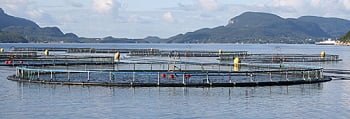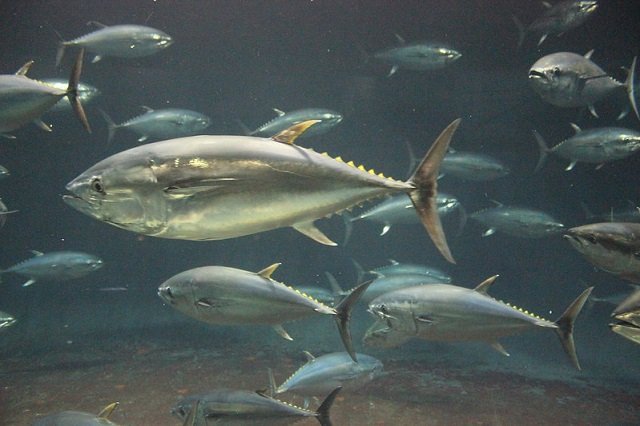
Acoustic telemetry has emerged as a valuable tool for studying fish behavior, both in the wild and in aquaculture environments. By equipping fish with electronic transmitters, researchers can collect data on their movements, physiological parameters, and interactions with the environment.
In this context, obtaining information on salmon behavior allows producers to optimize production practices, improve fish welfare, and reduce environmental impacts.
Scientists from Nord University, the Norwegian Computing Center, NTNU, and AquaLife R&D AS collected depth time-series records from individually farmed Atlantic salmon in commercial cages, with the aim of resolving the general swimming depth behavior of salmon during the marine production stage.
The importance of studying swimming depth
Swimming depth is a crucial aspect of fish behavior, with implications for welfare, growth, and survival. Several factors, including environmental conditions, parasitic infestations, and feeding regimes, can influence swimming depth patterns.
A data-driven study on swimming depth
To better understand salmon behavior, a recent study analyzed telemetry data from individual Atlantic salmon in commercial cages. Researchers focused on swimming depth patterns and how they were influenced by natural light conditions, water temperature, and operational conditions such as submerged lights and skirts.
Using tags with acoustic depth sensors, researchers collected data from 126 individual salmon in ten cages across five farming sites.
The tags recorded fish swimming depth every hour for a period of 195 to 316 days, covering all seasons. Researchers analyzed the data using generalized additive models (GAM) to identify the main effects of time of day, temperature, and daylight hours on fish swimming depth.
Key findings
- Diurnal depth patterns: Atlantic salmon generally resided higher in the water column at night than during the day, except in summer. This pattern was more pronounced in winter and spring, particularly in cages without submerged lights.
- Impact of submerged lights: The use of submerged lights altered diurnal depth patterns, leading fish to swim deeper at night during months with fewer daylight hours.
- Individual variations: The study also revealed large individual variations in swimming depth, highlighting the importance of considering individual behavioral traits when modeling expected depth patterns. This information can be used as a monitoring tool alongside real-time biomonitoring during the marine growth phase.
- Seasonal effects: Depth patterns were influenced by seasonal factors, with the most pronounced differences occurring in winter and spring.
Implications for aquaculture
These findings have important implications for Atlantic salmon aquaculture:
Stay Always Informed
Join our communities to instantly receive the most important news, reports, and analysis from the aquaculture industry.
- Behavioral monitoring: The study demonstrates the value of behavioral monitoring as a tool for understanding and managing salmon populations.
- Data-driven models: By analyzing swimming depth data, producers can develop data-driven models to predict fish behavior and optimize production practices.
- Fish welfare: Understanding salmon behavior can help improve fish welfare by identifying and addressing factors that may negatively affect their well-being.
- Environmental management: By optimizing production practices based on fish behavior, producers can reduce the environmental impact of aquaculture operations.
Conclusion
“The findings of the current study indicate notable seasonal variations in diurnal depth patterns of Atlantic salmon, both at the individual and population levels,” the researchers conclude.
In this sense, the study provides valuable insights into the swimming depth behavior of Atlantic salmon in commercial cages. By leveraging data-driven approaches and behavioral monitoring, the aquaculture industry can make informed decisions to improve fish health, productivity, and sustainability.
The study was funded by the CycLus project and the Aquatraz project by SalMar.
Contact
J.B. Ulvund
Faculty of Biosciences and Aquaculture, Nord University
8049 Bodø, Norway
Email: john.ulvund@gmail.com
Reference
Ulvund, J., Tvete, I., Aldrin, M., Alfredsen, J., Urke, H., Kristensen, T., & Jansen, P. (2025). Seasonal, diurnal and individual variation in Atlantic salmon (Salmo salar L.) swimming depth in commercial-scale sea cages. Aquaculture, 595, 741728. https://doi.org/10.1016/j.aquaculture.2024.741728
Editor at the digital magazine AquaHoy. He holds a degree in Aquaculture Biology from the National University of Santa (UNS) and a Master’s degree in Science and Innovation Management from the Polytechnic University of Valencia, with postgraduate diplomas in Business Innovation and Innovation Management. He possesses extensive experience in the aquaculture and fisheries sector, having led the Fisheries Innovation Unit of the National Program for Innovation in Fisheries and Aquaculture (PNIPA). He has served as a senior consultant in technology watch, an innovation project formulator and advisor, and a lecturer at UNS. He is a member of the Peruvian College of Biologists and was recognized by the World Aquaculture Society (WAS) in 2016 for his contribution to aquaculture.




